Not long after the Wright Brothers’ historic first flight in Kitty Hawk, North Carolina, airplanes became weaponized to achieve a vast array of objectives. Speed, range, firepower, and agility are just some of the contributory factors to determine which aircraft are most praiseworthy. But what is the greatest warbird of all time? It’s a tough question — like asking a sports fan to name the best athlete who ever lived (hint: it’s Jim Thorpe).
So before you start firing bullet-riddled comments, please understand this list is merely a general consensus among military historians, fighter jocks and aviation experts who know a thing or two about thrust, drag, lift, and weight — aka the four forces of flight. Furthermore, the entries presented are not ranked in any specific order other than their initial arrival in the air.
10. Albatros D.III

Legendary pilot Manfred von Richthofen (“The Red Baron”) is probably best known for his brightly colored, three-winged Fokker Dr. I. However, the famous ace of aces achieved most of his 80 kills during WWI in an Albatros D.III. The German plane benefitted from a lightweight frame made of plywood, a 170 hp Mercedes D.III inline water cooled engine, and armed with twin 7.92 mm LMG 08/15 machine guns.
The Berlin-based Albatros-Flugzeugwerke first introduced the fighter in 1916. Its acrobatic maneuverability saw the Richthofen’s Jagdgeschwader I (“Fighter Wing 1”) dominate the skies in what came to be known as “The Flying Circus.” The D.III enjoyed its greatest success in 1917 during “Bloody April” — a month in which the Germans shot down 245 British aircraft over the skies of northern France.
Although its agility and climb rate drew rave reviews, one major design flaw presented grave problems. Early variants featured a Teves und Braun airfoil-shaped radiator in the center of the upper wing, which if punctured by enemy gunfire, tended to scald the pilot’s face. Yikes. Subsequently, the part was modified and moved to the right of its original placement.
9. Royal Aircraft Factory S.E.5a
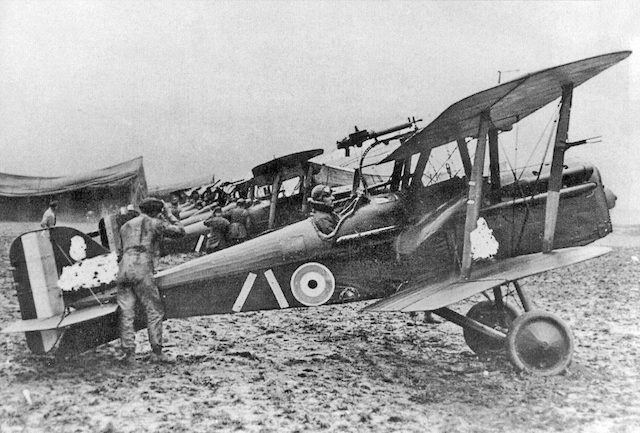
As attrition for the Allies continued to mount towards the end of WWI, British engineers worked feverishly to produce a fighter that was both easier to fly and at least equal to those pesky German planes. That soon changed with the rollout of the Royal Aircraft Factory S.E.5a in 1917. Featuring a powerful 200-hp Hispano-Suiza (or Wolseley Viper) water-cooled engine, the Scout Experimental 5 provided outstanding high-altitude performance, easier handling than the Sopwith Camel, and ranked as one of the swiftest flyers of the war with a top speed of 138 mph.
Different versions of the S.E.5a, however, were not without its share of engine-related grief. But once the kinks were worked out, the fighter became a favorite of both novice pilots as well as top aces, including Billy Bishop, Alan Ball, James McCudden, and Edward Mannock.
Along with the added boost of American doughboys, the S.E.5a helped turn the tide on the Western Front, equipping 21 British and two U.S. squadrons. Over 5,000 were produced at the plant in Farnsworth, England with armament that included a synchronized .303-inch Vickers machine gun, a wing-mounted Lewis gun, and four (two under each wing) 18-kilogram Cooper bombs.
8. Spitfire

The battle-scarred Spitfire that hangs prominently inside the Imperial War Museum in London is a fitting tribute to its rightful place in history. The Royal Air Force (RAF) fighter not only helped thwart Hitler’s plans to invade the U.K. but served as an iconic symbol of resistance throughout the war. Prime Minister Winston Churchill said it best when expressing his gratitude regarding the Battle of Britain, “Never in the field of human conflict was so much owed by so many to so few.
Designed by R. J. Mitchell at Supermarine Aviation Works, the Spitfire first took flight in 1936 near its production facility in Southampton, England. Mitchell, a well-respected aeronautical engineer, aimed to build a short-range, high-performance bomber interceptor capable of exploiting the powerful Rolls Royce V-12 Merlin engine. He also managed to create a gorgeous-looking plane, characterized by its sleek fuselage, elliptical wings, and long, regal nose.
Early variants of the fighter featured eight .303 Browning guns in the wings that were later replaced or augmented with 20mm Hispano MkII cannons. The Spitfire’s impressive climb rate and deft maneuverability would become its defining hallmark, engaging in epic duels with its main German rival, the Messerschmitt Bf-109. To be fair, the RAF Hawker Hurricane inflicted 60 percent of enemy aircraft during the Battle of Britain but also had nearly twice the number of planes.
After the homeland threat subsided, Spitfires also served as fighter-bombers and carrier-based fighters, earning similar distinction in all combat theaters.
7. A6M Zero

Japan’s founding mythology holds that its first ruler, Emperor Jimmu, ascended to the throne in 660 B.C. Flash forward to 1940, when special celebrations were held to mark the 2,600th year anniversary while at the same time, Mitsubishi began mass production of the Imperial Navy’s new aircraft carrier-based fighter, A6M. The official name was Rei-shiki kanjo sentoki or model zero carrier-based fighter — the “zero” in this case referred to the last digit of 2,600 — and thus simply shortened to Zero.
Arguably the best fighter plane of WWII, the Zero built its much-feared dogfighting reputation based on superb agility, speed, and range, and would later apply the same qualities to making outstanding cars for fighting rush hour traffic. The lightweight aluminum frame allowed for a top speed of 331 mph and a range of 1930 miles. Its armament consisted of two 7.7mm machine guns, two 20mm cannons in its wings and could carry two 132-pound bombs.
The Zero easily outclassed most of its rivals in early combat operations. The surprise attack on Pearl Harbor on December 7,194 saw the Japanese Imperial Navy launch 353 aircraft from six carriers, including scores of Zeroes that stuck a crippling blow to U.S. Pacific Fleet.
As the war progressed, however, the Allies built more formidable weaponry to mitigate the Japanese advantage. The Zeros would later be used in more Kamikaze suicide attacks than any other airplane. A total of nearly 11,000 Zeros were manufactured overall, making it the most produced Japanese fighter of the war.
6. P-51D Mustang
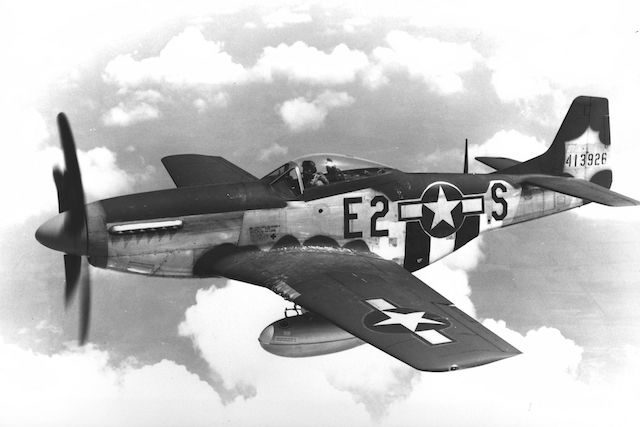
Der P-51 ist einer der Hauptgründe, warum dieser Artikel nicht vollständig in deutscher Sprache verfasst ist. (Translation: the P-51 is one of the primary reasons why this article isn’t written entirely in German.) Although “greatness” is often a matter of conjecture, few will argue that the P-51D Mustang is the fighter plane most responsible for pushing the Allies to victory in the ETO (European Theater of Operations).
Originally developed for the RAF by North American Aviation (a division of General Motors), the P-51 (P for Pursuit) design underwent numerous modifications before taking over air superiority from the Luftwaffe. The most significant change involved the replacement of the original Allison V-1710 engine with a supercharged Rolls Royce Merlin (built under license by Packard Motor Car Company) that boasted a max speed of 440 mph and a range of 1,600 miles.
The rugged, beefy fighter-bomber’s large fuel tanks allowed for round trip sorties from England to Berlin, and arrive back home in time for dinner. Equipped with six Browning .50 machine guns, the ferocious dogfighter could simply fly faster and farther than most other combat aircraft of its era. Furthermore, the Mustang claimed the most kills during WWII with 281 pilots earning the “Ace” distinction of five kills. Famed test pilot and aviation record-setter, Chuck Yeager, achieved the rare feat of becoming an “Ace in a Day” by shooting down five Me 109s in his P-51D “Glamorous Glen III,” which he named for his wife. (Insert “Right Stuff” pun here.)
The Mustang also saw extensive action during the Korean War, even after jet fighters became available. Today, the beloved P-51D can be seen at several national museums such as the Military Aviation Museum in Pungo, Virginia, and remains a fan favorite at air shows worldwide.
5. B-29 Superfortress
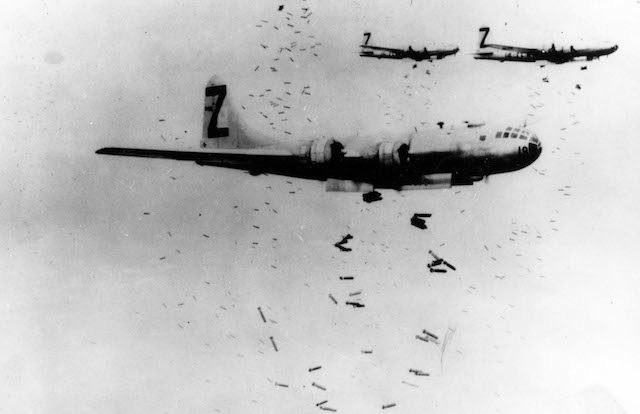
In the closing months of WWII, U.S. President Harry S. Truman faced a difficult decision: continue a protracted war in the Pacific against a beleaguered enemy, or become the first nation to use nuclear weapons on people. Ultimately, “Give ‘em Hell Harry” chose the latter — and tasked the Boeing B-29 Superfortress for the top-secret mission over Japan.
As the Allies prepared for D-Day, the B-29 conducted its first combat operation thousands of miles away in Axis-partnered Thailand. The attack would serve as a precursor to an ambitious bombing strategy of the Japanese mainland, designed by Major General Curtis LeMay of the XXI Bombing Command. At the time, the B-29 was the largest and most advanced bomber ever built, featuring a pressurized cabin, analog computer controls, automated gun stations and four Wright Duplex Cyclone 2,200-hp engines. More importantly, however, the high-altitude aircraft had a range of 3250 miles and a massive payload capacity.
The Superfortress also proved to be an effective, nighttime low-altitude bomber that included several devastating raids on Tokyo. However, when the Japanese refused to surrender, Truman gave the green light to utilize two types of atomic bombs developed by the Manhattan Project. A modified, lighter (and mostly unarmed) version of the B-29 called “Silverplate” were modified for the monumental operation.
Finally, on August 6, 1945, the “Enola Gay” dropped the world’s first atomic bomb on Hiroshima. Three days later, the “Bockscar” dropped its payload on Nagasaki. Japan surrendered shortly afterward. They remain the only two nuclear weapons ever used in combat.
4. F-86 Sabre
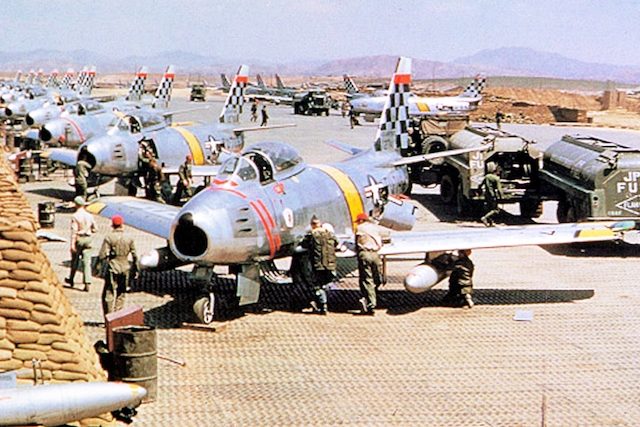
Yankees-Red Sox. Lakers-Celtics. Army-Navy. Great rivalries often bring out the best in opposing teams. The same can be said of the fierce battles fought between the F-86 Sabre and MiG-15 in the Korean War. Oddly, however, sometimes evenly matched sides can produce lopsided results regardless of who’s calling the shots. Such was the case of America’s first transonic fighter jet that consistently schooled the Soviet-made (and frequently Soviet-piloted) Mikoyan-Gurevich — better known as the MiG.
The F-86 Sabre easily makes this list as one of the feared and successful combat jets of all time. Owning an impressive kill ratio of 10:1 while dueling over “MiG Alley”, the U.S. warbird had plenty to crow about. Produced by North American Aviation (same maker as the P-51 Mustang) beginning in 1949, the Sabre was also the first jet designed with a swept wing to counter the leading edge compression shock wave. Proving all is fair in love and war, F-86 designers capitalized on captured German aerodynamic data from the Messerschmitt Me 262, the world’s first operational jet-powered fighter.
Most Sabres came equipped with six .50 M3 machine guns capable of firing 1,200 rounds per minute. Later variants could carry up to 2,000 pounds worth of bombs and/or air-to-ground rockets and could reach an altitude of nearly 50,000 feet. In his “Beauteous Butch II,” Capt. Joseph McConnell Jr. became the top U.S. ace in the Korean war with 16 victories. It’s also worth noting that future Mercury Astronaut and U.S. Senator John “The MiG Mad Marine” Glenn shot down three of the Soviet jets in his F-86 pilot in 1953. (Insert second “Right Stuff” pun here).
Over the years, nearly 10,000 F-86s were produced in a multitude of variants and became the primary jet fighter of several Allied air forces until it was finally retired in Bolivia in 1994.
3. Sea Harrier
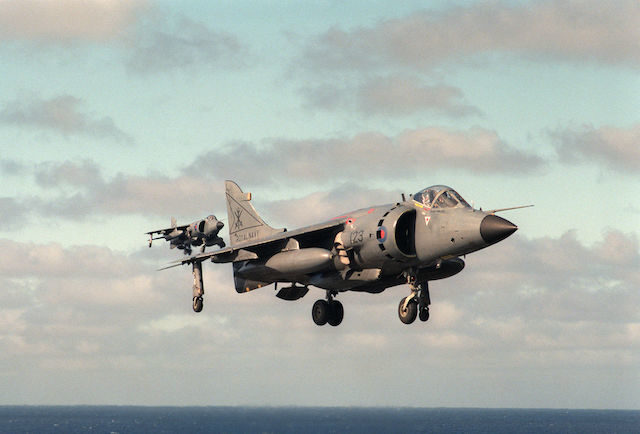
The Falklands War between Great Britain and Argentina turned out to be a short-lived confrontation with a long-disputed history dating back over 200 years. The largely forgettable conflict lasted only 72 days, resulting in a resounding British victory and the return of its Patagonian lands that are home to more penguins than people. However, the extraordinary show put on by RAF Sea Harriers “Jump Jets” provided a memorable performance for the ages.
First developed by British aircraft manufacturer Hawker Siddeley in the late 1960s, the Harrier (named for a tenacious bird of prey) became the first operational jet airplane capable of vertical/short takeoff and landing (V/STOL). No runway? No problem. Powered by a Rolls-Royce Pegasus turbofan engine with two intakes and four vector-able nozzles, the Harrier’s ability to launch like a rocket and hover like a helicopter (as well as reach a top speed of 730 mph) put this versatile weapon in a class all by itself when duty called in the Spring of 1982.
The Argentine junta (Argentina’s military regime) decided to flex some muscle and invade the disputed rocky archipelago off its deep southern coast. Buenos Ares reasoned the action would provide a distraction from the country’s recent economic woes and hoped that the United Kingdom wouldn’t bother to respond militarily. Big mistake. Picking a similar fight with Chile in the not-as-challenging Beagle Conflict would have been a much better idea.
The Royal Navy, as they’ve done for centuries, quickly mobilized and barreled into the open seas with all its maritime might. But this time, they brought with them a flock of Sea Harriers equipped with AIM-9 Sidewinder missiles ready to do the business. All totaled, jump jet squadrons shot down 21 Argentine planes (including much faster Mirage III jets) in air-to-air combat without a single air-to-air loss. In other words, a clean sheet for the Three Lions.
But no need to cry for Argentina, folks. Four years later, the South Americans got their revenge when Diego Maradona’s infamous “Hand of God” knocked England out of the 1986 World Cup and propelled the Argentines to another Copa del Mundo. As for the Sea Harrier, the vaunted aircraft would see additional combat during the Balkans Crisis before finally retiring in 2006.
2. B-2 Spirit
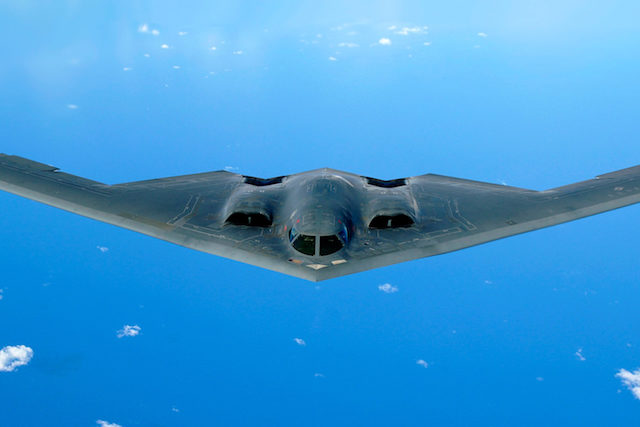
Boasting a flying wing design, stealth technology, and looking more like something you’d find in a Star Wars movie, the B-2 Spirit would make even Darth Vader quake in his boots. Plans for this long-range strategic bomber had been around since the 1970s and was originally intended to carry nuclear bombs deep into the former Soviet Union just in case the Cold War suddenly got boiling hot. But after countless delays, costly budget overruns, and four U.S. presidential administrations later, the Northrup Grumman behemoth finally became operational in 1997.
The two-seat bomber is powered by four 17,000-pound thrust General Electric F-118 turbofans, can reach speeds of just under Mach one, operate at 50,000 feet, hold a whopping 40,000 pounds of ordnance (conventional or nuclear), and fly for over 6,000 miles before refueling. However, it’s main selling point is its super sneaky stealth capabilities — which helps explain its jaw-dropping adjusted price tag of about 2.2 billion a pop.
As the second U.S. warplane with advanced stealth technology following the Lockheed F-117 Nighthawk, the B-2’s unique shape makes it virtually invisible to radar. Additionally, the frame consists of low-reflective carbon-fiber composites and a special coating that further reduces radar reflectivity — a service probably not offered at your local body and paint shop.
Stationed at Whiteman AFB near Kansas City, Missouri, the Spirit first saw action in the Kosovo War in 1999, and later served in Iraq, Afghanistan, and Libya. To date, 21 B-2s have been produced, but one crashed in Guam in 2008, making it the most expensive loss of aviation history.
1. F-22 Raptor

True to its nickname, the F-22 is a fearsome beast. The lethal combination of stealth, speed, maneuverability, and a multitude of other classified bells and whistles makes the Raptor one of the baddest birds on the planet. A USAF pilot with F-22 combat experience put it this way: “Imagine you’re a sniper at night with night-vision goggles and a high-powered rifle and the guy you’re up against has no goggles and a pistol. That’s what it’s like flying the F-22.”
The world’s first fifth-generation fighter jet is a joint project by Lockheed Martin and Boeing and first entered service in 2005. Its primary role is to provide air superiority, but it can also serve various other functions, including ground attack, electronic warfare and signal intelligence. After waiting nine long years in the nest, the Raptor saw its first action ion 2014, going after ISIS targets in Northern Syria.
Although the Raptor is capable of reaching a max speed of Mach 2.25 (1726 mph), one of its defining characteristics is the ability to cruise at Mach 1.5 without afterburners. And like the B-2, the F-22 is almost invisible to radars — or in pilot jargon, enjoys “low observability.” In short, it can fly faster and longer because it burns less fuel, and is more or less undetectable. Also, federal law prevents the F-22 from being exported to other allies and NATO countries in order to protect its confidential, hush-hush, stealth technology.
Being on top, however, means there are plenty of others out there that want to knock the Raptor off its lofty perch. To name a few: Sukhoi Su-57 (Russia), Eurofighter Typhoon (European Union), Dassault Rafale (France) and the Chengdu J-20 (China). Good luck.
1 Comment
Absolutely missing from this list: The WW 2 era Ilyushin 2 – Shturmovik, of which over 42.000 were produced in multiple variants, more than any other military plane up tol present day (!). Initially it was designed as a heavily armoured ground-attack aircraft, with later variants as heavy fighter and torpedo bomber earning nicknames as ‘Flying Tank’, ‘Flying Infantry Man’ and ‘Black Death’, the latter by the Germans. It played a major role in every battle on the Eastern Front and Manchuria with a later version even making it through the Korean War.
The importance of the Shturmovik is demonstrated clearly in a quote attributed to the Soviet leader Stalin who during the war once told a factory director: “… Shturmoviks are as essential to the Red Army as air and bread…”.
Given its numbers produced, its impact on the WW 2 battlefields and the impulse it gave to a re-assessment of the design of future ground-attack aircraft such as the AD-1 Skyraider, A-10 Warthog and Sukhoi 25 Frogfoot, the majority of the planes in this list look a bit pale.